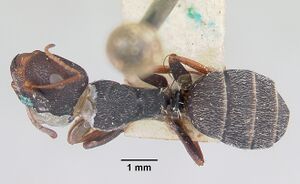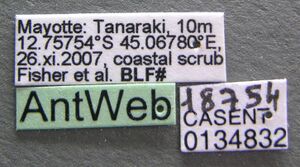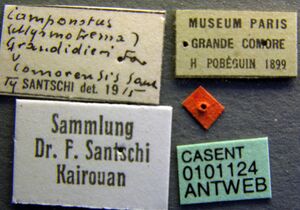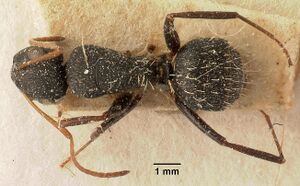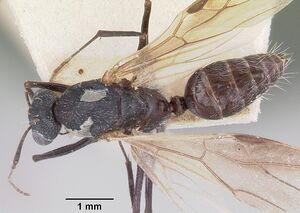AntWiki: The Ants --- Online
Camponotus grandidieri is widespread in Africa and the Malagasy region. In the latter it occupies many different types of habitats, but is absent on Reunion Island. It has been collected from coastal scrub and littoral forest to spiny forest and tropical dry forest through montane rainforest and savannah woodland. It is also known from mangrove forest and human-dominated areas such as urban gardens and roadsides. Across these habitats, colony nests have been found most often in dead branches above the ground and in rotten logs, and rarely in dead tree stumps, rot pockets and trunks of live trees, under rocks, and under root mats and litter on rocks. Individual workers forage on the ground and on lower vegetation.
Identification
A member of the Camponotus grandidieri species group.
Rakotonirina et al. (2017) - Body color black. A few pairs of whitish erect hairs confined to posteromedian portion of head; gap between two hairs on promesonotum usually larger than length of hair. Erect hairs on uppermost portion of petiolar node, posterodorsal angle of propodeum, and junction between lateral propodeal surface and declivity equal to or longer than distance between posteroventral angle of mesosoma and propodeal spiracle.
See discussion under Camponotus auropubens.
Keys including this Species
Distribution
Latitudinal Distribution Pattern
Latitudinal Range: 12.38051° to -33.16667°.
Afrotropical Region: Comoros (type locality), Kenya, Mozambique, Namibia, Zimbabwe.
Malagasy Region: Madagascar (type locality), Mauritius, Mayotte, Seychelles.
Distribution based on AntMaps
Distribution based on AntWeb specimens
Check data from AntWeb
Countries Occupied
| Number of countries occupied by this species based on AntWiki Regional Taxon Lists. In general, fewer countries occupied indicates a narrower range, while more countries indicates a more widespread species.
|

|
Estimated Abundance
| Relative abundance based on number of AntMaps records per species (this species within the purple bar). Fewer records (to the left) indicates a less abundant/encountered species while more records (to the right) indicates more abundant/encountered species.
|

|
Biology
Castes
Worker
Queen
Male
Nomenclature
The following information is derived from Barry Bolton's Online Catalogue of the Ants of the World.
- grandidieri. Camponotus grandidieri Forel, 1886c: ciii (s.w.) MADAGASCAR.
- [Camponotus grandidieri Forel, 1879a: 115. Nomen nudum.]
- [Misspelled as grandieri by Santschi, 1925h: 168.]
- Forel, 1891b: 39 (s.); Forel, 1892l: 232 (m.); Forel, 1912k: 166 (q.).
- Combination in C. (Myrmotrema): Forel, 1913a: 145.
- Subspecies of foraminosus: Mayr, 1893: 195; Forel, 1907d: 92; Forel, 1907e: 14; Forel, 1907g: 89; Forel, 1912k: 166; Forel, 1913a: 145.
- Status as species: Forel, 1886f: 187; Forel, 1891b: 39 (redescription); Forel, 1892l: 232; Dalla Torre, 1893: 233; Emery, 1894a: 72; Mayr, 1895: 150; Emery, 1895f: 337; Emery, 1896d: 377 (in list); Wasmann, 1897: 250; Mayr, 1907b: 21; Forel, 1914a: 270; Santschi, 1915c: 268 (in key); Wheeler, W.M. 1922a: 981, 1050; Arnold, 1924: 731; Emery, 1925b: 132; Santschi, 1925h: 168; Donisthorpe, 1946e: 34; Bolton, 1995b: 102; Dorow, 1996a: 85; Rakotonirina, et al. 2017: 223 (redescription).
- Senior synonym of atrabilis: Rakotonirina, et al. 2017: 218.
- Senior synonym of comorensis: Rakotonirina, et al. 2017: 218.
- Current subspecies: nominal plus eumendax, ruspolii.
- atrabilis. Camponotus (Myrmotrema) grandidieri var. atrabilis Santschi, 1915c: 273 (w.) MADAGASCAR.
- Subspecies of grandidieri: Wheeler, W.M. 1922a: 982, 1051; Emery, 1925b: 132; Bolton, 1995b: 86.
- Junior synonym of grandidieri: Rakotonirina, et al. 2017: 223.
- comorensis. Camponotus (Myrmotrema) grandidieri var. comorensis Santschi, 1915c: 274 (s.w.) COMORO IS.
- Subspecies of grandidieri: Wheeler, W.M. 1922a: 1051; Emery, 1925b: 132; Bolton, 1995b: 93.
- Junior synonym of grandidieri: Rakotonirina, et al. 2017: 223.
Unless otherwise noted the text for the remainder of this section is reported from the publication that includes the original description.
Description
Worker
Rakotonirina et al. (2017) - Minor In full-face view head small (CS: 1.23±0.13; 1.05–1.64) and as long as broad (CWb/CL: 0.92±0.03; 0.88–0.99), but slightly converging anteriorly; posterior margin more or less convex. Median portion of clypeus transversely trapezoidal (ClyL/GPD: 0.66±0.03; 0.60–0.71). Eyes either breaking lateral outlines of head or not, their posterior level located at posterior sixth portion of head (PoOc/CL: 0.16±0.01; 0.15– 0.19). Anterior clypeal margin truncate with obtuse lateral angle; posterior margin weakly notched medially. Mandible triangular, apical margin armed with six sharp teeth. Antennal scape long, approximately its distal portion surpassing posterior cephalic margin. In lateral view, outline of promesonotal dorsum broadly convex, without anterior and dorsolateral margination; propodeal dorsum inclined posteriorly. In dorsal view, mesosoma widest at level of pronotum and decreasing in width toward propodeal declivity. Propodeal spiracle opening slitlike. Petiolar node scalelike and tapering dorsally. Mesotibial and metatibial spurs pectinate.
Dorsolateral portion of head and mesosoma finely and densely reticulate punctate, punctures on lateral portion of mesosoma much larger. Gastral tergites with imbricate sculpture or much finer and denser reticulate punctures anteriorly, that become sparser posteriorly. Mandible imbricate superimposed with sparse piligerous punctures. Whitish erect hairs thinner and shorter on head and pronotum, becoming thicker from mesonotum through petiolar node and gastral segments. Hairs arranged as follows: a few pairs on median portion of head from clypeus to near posterior cephalic margin; a few pairs on pronotum, one to three pairs on mesonotum, scattered on propodeal dorsum and junction of lateral propodeal surface and declivity; a row on upper half of posterolateral margin of petiolar node. Some erect hairs on dorsum of petiolar node, posterodorsal angle of propodeum and junction between lateral propodeal surface and declivity equal to or longer than distance between posteroventral angle of mesosoma and opening of propodeal spiracle. On mesosoma, pubescence shorter than distance between hairs; on gastral tergites pubescence longer than distance between hairs; pubescence lacking on upper half of mesopleuron. Body color black and dull; appendages basally reddish or dark brown, apical portion and antennae brown to light brown.
Major With characteristics of minor worker, except: head much larger (CS: 1.97±0.21; 1.56–2.21; CWb/CL: 1.03±0.04; 0.95–1.08); lateral margins slightly convex and converging to base of more robust mandibles. Apical margin of mandible with up to seven teeth. Median portion of clypeus more rectangular (ClyL/GPD: 0.88±0.07; 0.78–0.97). Eyes located more medially (CWb/CL: 1.03±0.04; 0.95–1.08; CW/CL: 0.92±0.02; 0.89– 0.95) and more anteriorly, their posterior level on posterior fifth of head (PoOc/CL: 0.20±0.01; 0.18–0.23). One fifth of apical portion of scape extending beyond posterior cephalic margin. In dorsal view, small portion of metanotum visible along midline of mesosoma, between metanotal groove and propodeum. Sculpture of lateral portion of head from near base of mandible, along level of interior ocular margin, to level of postocular margin imbricate, superimposed with sparse, larger punctures, which are equipped with two to four smaller punctures from which one appressed hair arises medially. More pairs of whitish erect hairs on median portion of head; numerous on promesonotum. Body color the same as minor except mandibles, anterior portion of clypeus, and anterolateral portion of head darker in color.
Type Material
- Camponotus grandidieri: Lectotype (designated by Rakotonirina, Csosz & Fisher, 2017: 223), minor worker, unspecified locality, Madagascar, Voeltzkow, CASENT0101121, Naturhistorisches Museum, Basel.
- Camponotus grandidieri: Paralectotype (designated by Rakotonirina, Csosz & Fisher, 2017: 223), 1 worker, unspecified locality, Madagascar, Voeltzkow, CASENT0101120, Naturhistorisches Museum, Basel.
- Camponotus grandidieri: Paralectotype (designated by Rakotonirina, Csosz & Fisher, 2017: 223), 3 workers, unspecified locality, Madagascar, Voeltzkow, CASENT0101368, CASENT0101369, CASENT0101370, Musee d'Histoire Naturelle Genève.
- Camponotus grandidieri: Paralectotype (designated by Rakotonirina, Csosz & Fisher, 2017: 223), 3 males, unspecified locality, Madagascar, Voeltzkow, CASENT0101371, Musee d'Histoire Naturelle Genève.
- Camponotus grandidieri atrabilis: Lectotype (designated by Rakotonirina, Csosz & Fisher, 2017: 223), minor worker, Sainte Marie, Toamasina province, Madagascar, Voeltzkow, CASENT0101122, Musee d'Histoire Naturelle Genève.
- Camponotus grandidieri atrabilis: Paralectotype (designated by Rakotonirina, Csosz & Fisher, 2017: 223), 1 worker, Sainte Marie, Toamasina province, Madagascar, Voeltzkow, CASENT0101123, Naturhistorisches Museum, Basel.
- Camponotus grandidieri atrabilis: Paralectotype (designated by Rakotonirina, Csosz & Fisher, 2017: 223), 1 worker, Sainte Marie, Toamasina province, Madagascar, Voeltzkow, CASENT0102452, Musee d'Histoire Naturelle Genève.
- Camponotus grandidieri comorensis: Lectotype (designated by Rakotonirina, Csosz & Fisher, 2017: 223), major worker, Grande Comore, Comoros, H. Pobéguin, CASENT0101125, Naturhistorisches Museum, Basel.
- Camponotus grandidieri comorensis: Paralectotype (designated by Rakotonirina, Csosz & Fisher, 2017: 223), major worker, Grande Comores, Comoros, H. Pobéguin, CASENT0101124, Naturhistorisches Museum, Basel.
References
- Bolton, B. 1995b. A new general catalogue of the ants of the world. Cambridge, Mass.: Harvard University Press, 504 pp. (page 102, catalogue)
- Forel, A. 1879a. Études myrmécologiques en 1879 (deuxième partie [1re partie en 1878]). Bull. Soc. Vaudoise Sci. Nat. 16: 53-128 (page 115, Camponotus grandidieri, nomen nudum)
- Forel, A. 1886c. Diagnoses provisoires de quelques espèces nouvelles de fourmis de Madagascar, récoltées par M. Grandidier. Ann. Soc. Entomol. Belg. 30:ci-cvii. (page ciii, soldier, worker described)
- Forel, A. 1891c. Les Formicides. [part]. In: Grandidier, A. Histoire physique, naturelle, et politique de Madagascar. Volume XX. Histoire naturelle des Hyménoptères. Deuxième partie (28e fascicule). Paris: Hachette et Cie, v + 237 pp. (page 39, soldier described)
- Forel, A. 1892k. Les Formicides de l'Empire des Indes et de Ceylan. Part I. J. Bombay Nat. Hist. Soc. 7: 219-245 (page 232, male described)
- Forel, A. 1907h. Formiciden aus dem Naturhistorischen Museum in Hamburg. II. Teil. Neueingänge seit 1900. Mitt. Naturhist. Mus. Hambg. 24: 1-20 (page 14, Variety/subspecies of foraminosus)
- Forel, A. 1912l. The Percy Sladen Trust Expedition to the Indian Ocean in 1905, under the leadership of Mr. J. Stanley Gardiner, M.A. Volume 4. No. XI. Fourmis des Seychelles et des Aldabras, reçues de M. Hugh Scott. Trans. Linn. Soc. Lond. Zool. (2) 15: (page 166, queen described)
- Forel, A. 1913a. Fourmis de Rhodesia, etc. récoltées par M. G. Arnold, le Dr. H. Brauns et K. Fikendey. Ann. Soc. Entomol. Belg. 57: 108-147 (page 145, Combination in C. (Myrmotrema))
- Forel, A. 1914a. Le genre Camponotus Mayr et les genres voisins. Rev. Suisse Zool. 22: 257-276 (page 270, Revived status as species)
- Mayr, G. 1893b. Formiciden von Herrn Dr. Fr. Stuhlmann in Ost-Afrika gesammelt. Jahrb. Hambg. Wiss. Anst. 10: 194-201 (page 195, Variety/subspecies of foraminosus)
- Rakotonirina, J.C., Csosz, S., Fisher, B.L. 2017. Taxonomic revision of the Malagasy Camponotus grandidieri and niveosetosus species groups (Hymenoptera, Formicidae) using qualitative and quantitative morphology. Zootaxa 4238: 203–245 (doi:10.11646/zootaxa.4238.2.2).
- Rasoamanana, N., Fisher, B.L. 2022. A taxonomic revision of the Malagasy endemic subgenus Mayria of the genus Camponotus (Hymenoptera, Formicidae) based on qualitative morphology and quantitative morphometric analyses. ZooKeys 1081: 137–231 (doi:10.3897/zookeys.1081.71872).
- Donisthorpe, Horace. 1946. The Ants (Hym. Formicidae) of Mauritius. Annals and Magazine of National History. Ser. 11. 13:25-35.
- Dorow, Wolfgang H. O. 1995. Review and Bibliography of the ants of the Seychelles (Hymenoptera: Formicidae). J. Afr. Zool. 110:73-96
- Dorow, Wolfgang H.O. 1996. Review and bibliography of the ants of the Seychelles. Journal of African Zoology 110(2): 73-95.
- Emery C. 1886. Saggio di un catalogo sistematico dei generi Camponotus, Polyrhachis e affini. Memorie della Reale Accademia delle Scienze dell'Istituto di Bologna 5: 363-382
- Emery C. 1894. Mission scientifique de M. Ch. Alluaud aux îles Séchelles (mars, avril, mai 1892). 2e mémoire. Formicides. Annales de la Société Entomologique de France 63: 67-72.
- Emery C. 1895. Mission scientifique de M. Ch. Alluaud dans le territoire de Diego-Suarez (Madagascar-nord) (Avril-août 1893). Formicides. Annales de la Société Entomologique de Belgique 39: 336-345.
- Emery C. 1899. Formiche di Madagascar raccolte dal Sig. A. Mocquerys nei pressi della Baia di Antongil (1897-1898). Bullettino della Società Entomologica Italiana 31: 263-290.
- Fisher B. L. 1997. Biogeography and ecology of the ant fauna of Madagascar (Hymenoptera: Formicidae). Journal of Natural History 31: 269-302.
- Fisher B. L. 2003. Formicidae, ants. Pp. 811-819 in: Goodman, S. M.; Benstead, J. P. (eds.) 2003. The natural history of Madagascar. Chicago: University of Chicago Press, xxi + 1709 pp.
- Fisher B. L. 2005. A new species of Discothyrea Roger from Mauritius and a new species of Proceratium Roger from Madagascar (Hymenoptera: Formicidae). Proceedings of the California Academy of Sciences (4)56: 657-667.
- Forel A. 1886. Diagnoses provisoires de quelques espèces nouvelles de fourmis de Madagascar, récoltées par M. Grandidier. Annales de la Société Entomologique de Belgique. 30: ci-cvii.
- Forel A. 1886. Études myrmécologiques en 1886.. Annales de la Société Entomologique de Belgique. 30: 131-215.
- Forel A. 1887. Fourmis récoltées à Madagascar par le Dr. Conrad Keller. Mitteilungen der Schweizerischen Entomologischen Gesellschaft 7: 381-389.
- Forel A. 1897. Ameisen aus Nossi-Bé, Majunga, Juan de Nova (Madagaskar), den Aldabra-Inseln und Sansibar, gesammelt von Herrn Dr. A. Voeltzkow aus Berlin. Mit einem Anhang über die von Herrn Privatdocenten Dr. A. Brauer in Marburg auf den Seychellen und von Herrn Perrot auf Ste. Marie (Madagaskar) gesammelten Ameisen. Abhandlungen der Senckenbergischen Naturforschenden Gesellschaft 21: 185-208.
- Forel A. 1907. Ameisen von Madagaskar, den Comoren und Ostafrika. Wissenschaftliche Ergebnisse. Reise in Ostafrika 2: 75-92.
- Forel A. 1907. Formiciden aus dem Naturhistorischen Museum in Hamburg. II. Teil. Neueingänge seit 1900. Mitt. Naturhist. Mus. Hambg. 24: 1-20.
- Forel A. 1907. The Percy Sladen Trust Expedition to the Indian Ocean in 1905, under the leadership of Mr. J. Stanley Gardiner, M.A. VI. Fourmis des Seychelles, Amirantes, Farquhar et Chagos. Trans. Linn. Soc. Lond. Zool. (2) 12: 91-94.
- Forel A. 1909. Fourmis du Musée de Bruxelles. Fourmis de Benguela récoltées par M. Creighton Wellman, et fourmis du Congo récoltées par MM. Luja, Kohl et Laurent. Annales de la Société Entomologique de Belgique 53: 51-73.
- Forel A. 1912. The Percy Sladen Trust Expedition to the Indian Ocean in 1905, under the leadership of Mr. J. Stanley Gardiner, M.A. Volume 4. No. XI. Fourmis des Seychelles et des Aldabras, reçues de M. Hugh Scott. Trans. Linn. Soc. Lond. Zool. (2) 15: 159-167.
- Goodman S., Y. Anbdou, Y. Andriamiarantsoa, B. L. Fisher, O. Griffiths, B. Keitt, J. J. Rafanomezantsoa, E. Rajoelison, J. C. Rakotonirina, L. Ranaivoarisoa et al. 2017. Results of a biological inventory of the Nosy Ankao island group, Parc National de Loky-Manambato, northeastern Madagascar. Malagasy Nature, Association Vahatra, 2017, 11, <http://www.vahatra.mg/volume11fr.html>
- IZIKO South Africa Museum Collection
- Mamet R. 1954. The ants (Hymenoptera Formicidae) of the Mascarene Islands. Mauritius Inst. Bull. 3: 249-259.
- Rakotonirina J. C., S. Csosz, and B. L. Fisher. 2017. Taxonomic revision of the Malagasy Camponotus grandidieri and niveosetosus species groups (Hymenoptera, Formicidae) using qualitative and quantitative morphology. Zootaxa 4238 (2): 203–245.
- Santschi F. 1915. Nouvelles fourmis d'Afrique. Annales de la Société Entomologique de France 84: 244-282.
- Santschi F. 1925. Formicidae. Mission Rohan-Chabot. 4(3): 159-168.
- Wheeler W. M. 1922. Ants of the American Museum Congo expedition. A contribution to the myrmecology of Africa. IX. A synonymic list of the ants of the Malagasy region. Bulletin of the American Museum of Natural History 45: 1005-1055
- Wheeler W. M. 1922. Ants of the American Museum Congo expedition. A contribution to the myrmecology of Africa. VIII. A synonymic list of the ants of the Ethiopian region. Bulletin of the American Museum of Natural History 45: 711-1004

















